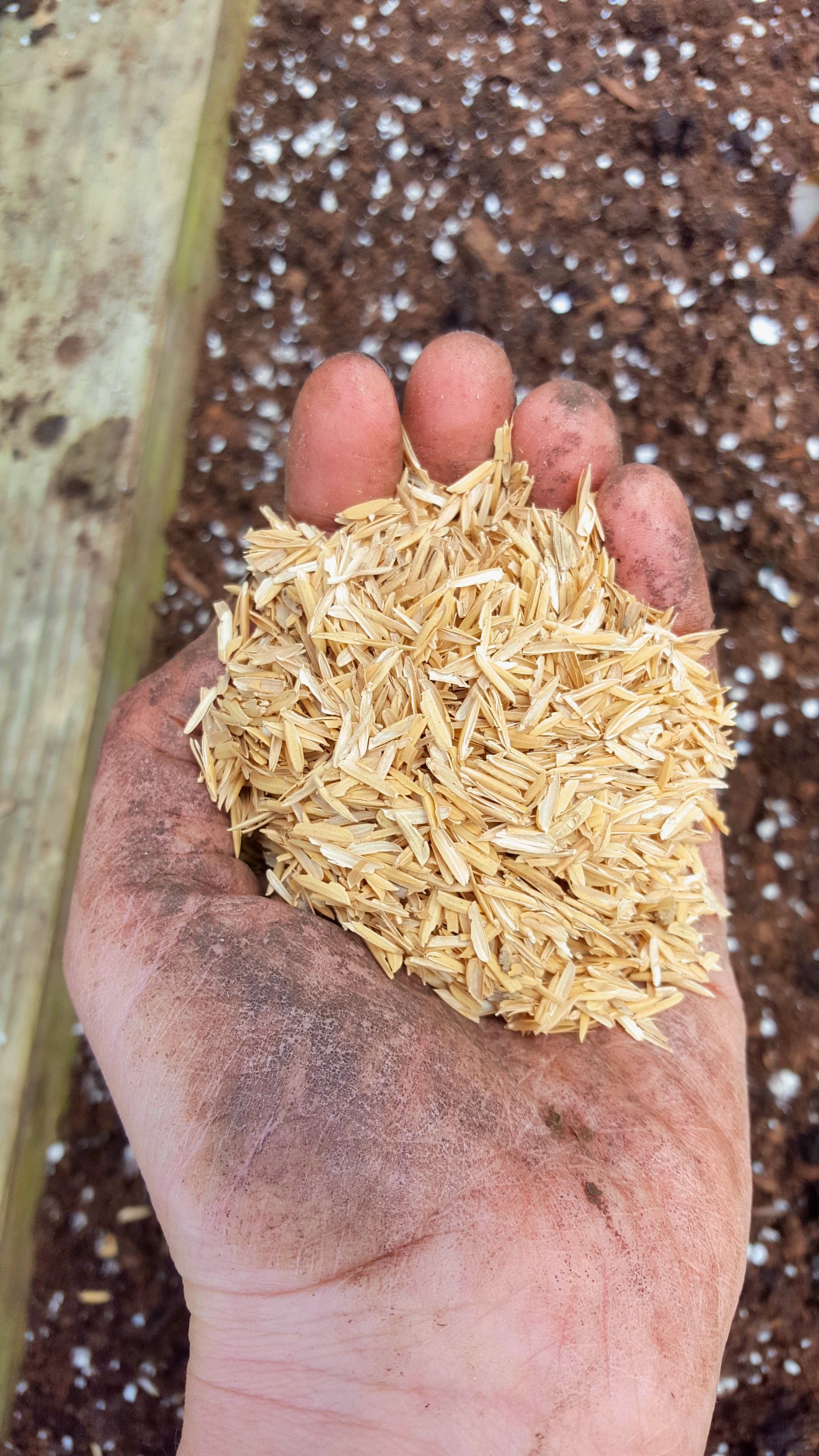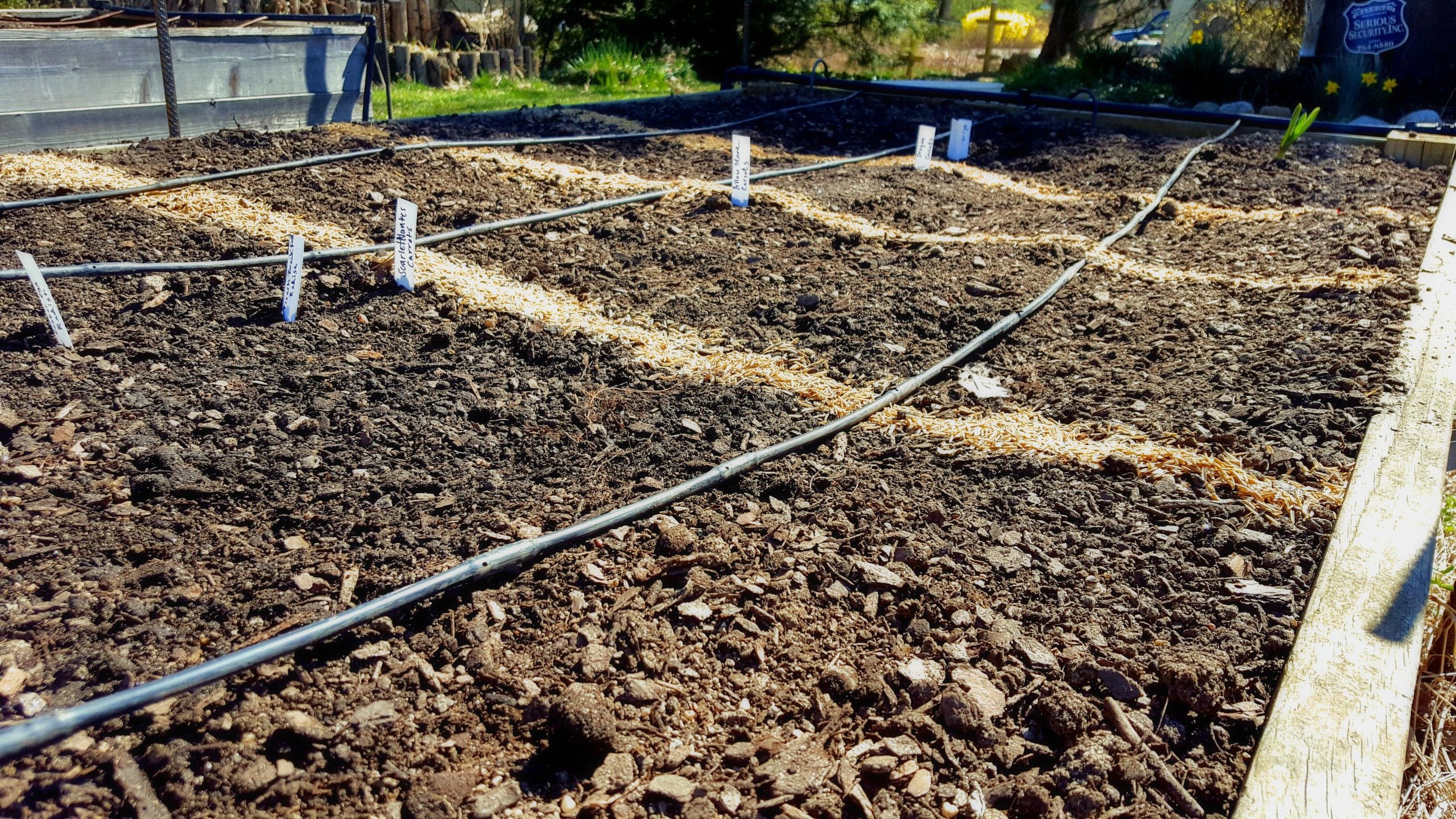As the largest native fruit in our region, Pawpaws are favorites in our edible landscaping. They can handle cold Winter temperatures and shady lighting, and they have relatively few pests.
Read moreRamping up for Spring
Ramps, or Wild Leeks, are wild edible plants in the allium family. Growing natively in the Appalachian mountains from Canada to North Carolina, ramps only appear for a few weeks before going to seed and disappearing for the Summer. As the first green to appear in early Spring, ramps have historically been celebrated as a sign of Spring and a tonic to the traditional Appalachian meat-heavy Winter diet.
Read moreRice Hulls
At Edible Eden, we spend a lot of time thinking about the larger impact of our work - we try to always choose the most responsible selection of plants, materials, and garden amendments that we can.
One eco-friendly material we love is rice hull! Rice hulls are the the husks around rice grains that are removed in processing. The hulls are then par-boiled to sterilize any rice grains and ensure no diseases are spread. We often use rice hulls to aerate, improve drainage, and retain water in our soils. Unlike the commonly used perlite and vermiculite, rice hulls are renewable resources. They do not have to be mined and no land is disrupted in their production: they would otherwise be considered a waste product! Unlike those other products, rice hulls are also organic material so they break down and add new nutrients to the soil over time. Because of this, you must refresh your beds with new hulls every year.
Rice hulls can also be used as a mulch much like straw or leaves. Use them to retain warmth or moisture in a bed or keep delicate seeds in place; we just topped our freshly planted carrot seeds with rice hulls to keep them from blowing away and provide good germinating conditions without burying them too deep.
Have you tried using rice hulls in your garden? Let us know what you think!
Garden to Table Recipe
Simple Roasted Vegetables
3-5 Fennel bulbs, trimmed and sliced into 1 inch slices.
1 large Celeriac, peeled and sliced into 1/4 inch slices
2-3 turnips, peeled and sliced
Broccoli broken into flowerettes
Olive oil
Salt and pepper
Never underestimate the ability of a little bit of olive oil, salt and pepper and 45 minutes or so in a hot over to transform lesser known (or loved) vegetables into something you will need to beat the kids off with a rolling pin if there are to be any left for dinner!
Some of my favorites are fennel, celeriac and turnips as well as old stand bys like broccoli and cauliflower.
Preheat over to 425. Cut your vegetables into distinctive bite size pieces, put in a bowl and drizzle with olive oil, Salt and pepper. Toss to coat. Arrange on a sheet tray. Bake for 30-45 minutes, depending on the vegetable, until crispy around the edges and soft in the middle. Fennel in particular takes a good long while to turn all soft and caramelized but believe me…it’s worth the wait.
To finish it off, sprinkle with parmesan cheese and bake for an additional 10 minutes. Serve with meat, fish, tofu, or anything else you can think of.
Sweet Sweet Serviceberry Jam
Serviceberry jam is a beautiful deep red color.
A fruit of many names, the serviceberry is also referred to as the juneberry, saskatoonberry, sarvisberry, shadberry, wild plum, or sugarplum plant. In mid-June (...right around now!) they begin to ripen, turning dark red or purple, and can be picked right off the branch to eat or preserve.
Read moreSpinach-packed Vegan Spanakopita!
Spinach is in its prime growing season and there's no tastier way to enjoy it than inside flaky, decadent spanakopita. Today, we tried baking a plant-based version of the pastry, swapping feta cheese for nuts, which was a huge success! Read more on our blog:
Fall Fennel Slaw
I love fennel; it’s one of my favorite fall veggies and grows great in our climate. One of the best ways to eat it is raw and whole like an apple. My next favorite way is in this mouth popping salad:
Alternatively, if you're dealing with confirmed fennel hater, convince them to try this:
Cherry Tomato Ginger Jam
Here is a recipe for one of my favorite things to do with the end of the season glut of cherry tomatoes.
Garlic Planting Time
The tomatoes are looking like skeletons, the cucurbits are covered in powdery mildew and it’s time to say goodbye to warm season crops and clear the way for the final flavors of the season and then the dormancy of winter.
Read morePreserving the Harvest
Nothing like a new baby to make a few months disappear. We welcomed Malakai Wolf to the world on August 5 and it has been quite a ride adjusting to being new parents! And suddenly it’s here, the first few days of October, the Jewish holidays, the rain, the chill and the FALL!
Read more
Cool Cucumber Soup
Most of us get distracted at some point in the season and fail to harvest some of those cucumbers- it’s hard to keep up with them when they really start fruiting! Here is a solution for those overgrown, seedy slicing cukes that are no good for pickling or salads. I like to serve in a small glasses with a crouton on top but it tastes just as good in a bowl!
Josh's Favorite Beet Recipe
Ever wonder what to do with beets? Well, this colorful root crop starts sizing up in late spring and can be grown all summer and into fall. Options for preparation are diverse and numerous but this is by far my favorite!
This makes a great side-dish to serve with fish or chicken or a beautiful addition to a meal of summer salads
Peak Summer Harvests & Baby Rosenstein
Here we are at peak summer and all that early season work should finally be paying off. All those fruiting plants: the tomatoes and cucumbers, zucchinis and eggplants, peppers and summer squash are all ripening on the vines. The onions, garlic, shallots as well as beets have matured and can be used now. The basil and other summer herbs are still going. Now is the time to be creative in the kitchen and, if you can stand the heat, get your Farm To Table cook on.
Unfortunately, this is also the season of fungal diseases, summer pests and extreme heat- so it can be easy to get distracted worrying about your plants survival. Indeed, the game now is to see how long you can keep some of these annual plants alive and yielding before they succumb to their eventual seasonal demise and make way for the rich hearty flavors of fall.
Truth be told, one of the real skills of a grower is getting the timing right. Many of our favorite fall crops must be planted around mid-August if they are to yield before winter conditions arrive, but often those precious summer crops are still occupying garden space long past that window.
What to do? Well, the first thing is make sure to have a garden plan to serve as a roadmap and guide planting decisions over the course of the season. Edible Eden offers garden plans for any size garden that will help maximize your space over the course of the season.
If you don’t have a plan in place; consider interplanting some fall crops in and amongst your yielding plants over the next few weeks so that when they do go down your kales and cabbages will rise to the occasion and fill their space.
Here at 2601 Taney, we are thinking a lot about timing as we continue our extended baby watch. Teri was at 40 weeks a week ago and now we are trying to go about our lives knowing that at any minute labor will begin and we will need to step away from whatever we were doing and head to the hospital.
It’s a good thing we have plenty of beautiful produce to munch while we are waiting!
Stay posted for news of the soon-to-arrive baby Rosenstein and enjoy that summer produce while it’s here.
Farmer Josh
Brassica Free July
Coming into the last few days of June it is time to get those brassicas out of there. Maybe you have had lingering broccoli heading up slowly in the early summer heat; or big beautiful kale plants playing their unique role in your garden aesthetics...well, their time has come!
Read moreNative Pollinator Gardens
While Edible Eden was founded to support people in local, seasonal eating and we do get most excited about interesting food plants...we also design and install ecological pollinator gardens using native plants and perennial cutting flowers.
Read moreEarly Summer Supper
It’s early June and the kale that was planted in April is now big and beautiful but has not yet turned leathery or bitter with heat. My favorite kale for this time of year is the Lacinato or Dinosaur kale but I have some curly as well. (In the fall, I love the red kale after it has survived a frost and is coarse and sweet).
Read moreSpring Spinach Salad
With the first days of heat the strawberries are starting to ripen. Meanwhile, we are still enjoying the last tender spinach leaves of spring before the spinach gets too hot and bolts.
Read moreGarden Tips: Garlic Scapes
Swan-necked Garlic Scape
It’s finally here, the long awaited garlic scape season- a bit early this year I might add. Garlic, as you know if you’ve planted it, gets planted in the fall in our climate, hunkers down beneath a layer of mulch all winter, and sends up a soaring, swan necked flower head in June.
Read moreEdible Landscaping
Here at Edible Eden we are always learning about and discovering great edible landscaping plants. At the moment I am mesmerized by common Sage (Salvia Officinalis). I’ve known that Sage was great to cook with and really shines when fried in butter until crispy and crumpled over butternut squash ravioli...
Read moreMushroom Logs for Mother's Day
Nothing says Mother's Day like Shiitake mushroom logs!
Read more
















